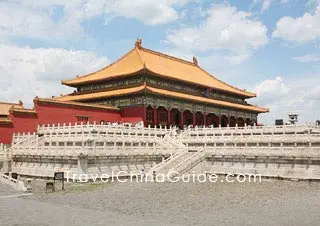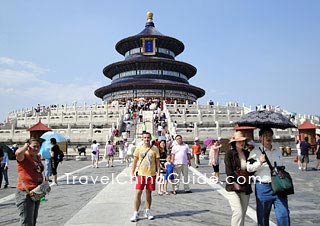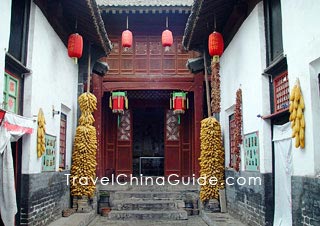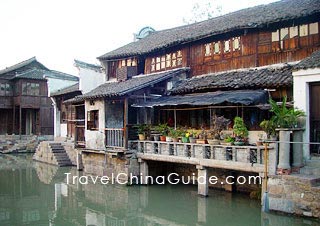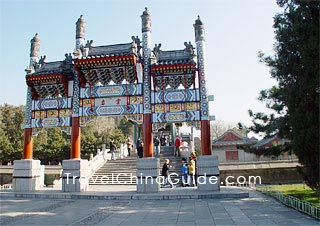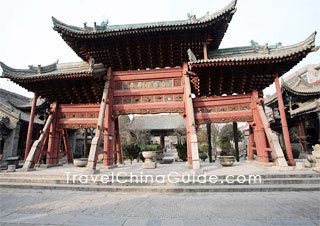Chinese Architecture Culture
Architecture and culture are tightly related to each other. In a sense, architecture is the carrier of culture. Styles of Chinese ancient architecture are rich and varied, such as temples, imperial palaces, altars, pavilions, official residencies and folk houses, which greatly reflect ancient thought - the harmonious unity of human beings with nature.
You may find much Chinese ancient architecture, is often composed of small yards. Instead of pursuing the over-dimensioned architecture such as western cathedrals, Chinese ancient people designed housings fit human dimensions so that they may feel intimate and safe, and this idea reflects the practical thinking in Chinese culture.
|
|
Two typical types of Chinese ancient architecture represent the profound influence of Chinese culture are Fengshui and Memorial arch.
|
|
Memorial Arch
(Paifang):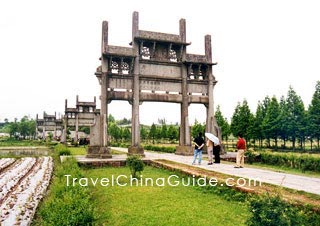 |
| Tangyue Memorial Archways, Shexian County, Huangshan |
Paifang symbolizes Chinese culture and has a long history. Early in the middle of the Spring and Autumn Dynasty (770 BC-476 BC), there was an architectural style, Hengmen, which was composed of two pillars supporting a beam. This style is supposed to be the precursor of Paifang. In the past, it was a very serious and ceremonious event to erect a Paifang.
Paifang can be divided into three types according to their different functions. 'Loyalty' Paifang is used to record a person's merit or great deeds. For example, Emperor Wanli in the Ming Dynasty (1368-1644) once ordered a loyalty Paifang to be built for Wang Xiangqian to honor his contribution to the country. If a person passed the imperial examinations, his family members would erect a Paifang because he brought honor to their ancestors. The 'Chastity' arch is built to honor a woman's loyalty to her husband. Other Paifang may contain little deep meaning; serving only as a symbol of a street or a village.
Each Paifang has its own cultural connotation and symbolization which are expressed in the beautiful colored patterns. The common designs on Paifang include dragon and phoenix, bat, deer and fish. The Paifang decorated with dragons and phoenix must belong to a royal family, because the dragon is the king of beasts and represent the emperor, while the phoenix is the queen of birds and represents the empress. 'Bat', in Chinese, is 'bianfu', with pronunciation similar to 'fu' (blessing); so the bat is regarded as a symbol of good luck and happiness. Deer sounds similar to 'lu' (salary), signifying promotion. Fish are carved on Paifang to represent the passing of an important test, an imperial examination, for example. Additionally, cypress, tortoise, water lily, peony and lotus leaf are often painted on Paifang to express the rich cultural connotation such as longevity, healthy, luck, happiness and so on.
|
|
- Last updated on Mar. 04, 2024 -
Questions & Answers on Chinese Architecture Culture
Asked by mia from USA | Mar. 04, 2024 14:11 Reply
Reply
Would you say that architecture, culture, and history of China are interconnected?
Answers (1)
Answered by Helen | Mar. 04, 2024 23:10 0
0 0
0 Reply
Reply
Yes, of course they are mutually influenced.
Asked by Ms.Xiao | Feb. 06, 2009 21:00 Reply
Reply
I'd like to know more the relationship between the women chastity and Paifang, typically the history and otigin of chastity arch
Answers (3)
Answered by Ms.Evelyn from CHINA | Feb. 09, 2009 01:02 0
0 0
0 Reply
Reply
It's intended for honoring a woman, who obeys her husband loyally and fulfill her filial duty to her mother-in-law and father-in-law.In a sense, chastity arch is a life description of the women who lived in feudal society. They were trampled by feudal ideology. Women were inferior to men. After husband died, she dare not remarry. If she was very loyal to her dead husband, she would be praised and endowed with a chastity arch. If she remarried, she would be looked down upon by others.
Answered by DYQ | May. 01, 2022 18:20 0
0 0
0 Reply
Reply
It had nothing to do with common people in ancient China. Only aristocratic families paid attention to female chastity.
Answered by Ivan Volkov | Jun. 19, 2022 16:00 0
0 0
0 Reply
Reply
Thanks
